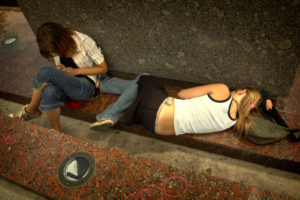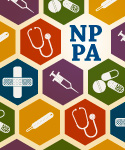December 8th, 2017
Trafficking: Taking Care of Sarah
Alexandra Godfrey, BSc PT, MS PA-C
Sarah
The neighbors called the police when they heard screaming. An officer discovered her hiding in a closet in a trailer. In the emergency room bay, I find Sarah naked except for a T-shirt. Her legs are drawn up, arms wrapped around her knees, head down. She looks severely malnourished, and her teeth are broken and decayed. Bites, bruises and stab wounds cover her body. There are strangulation marks on her neck. There are track marks on her skin. Someone has been stubbing out cigarettes on her arms.
Sarah doesn’t know her location, the time or the date. She has no documentation: no driver’s license, bank card, nothing. When I ask her whom she lives with in the trailer, she is too terrified to answer.
Sarah is 18 years old.
Trafficking is the recruiting, transporting, harboring or receiving of a person through force in order to exploit her or him for prostitution, forced labor or slavery.
According to the U.S. State Department, 600,000 to 800,000 people are trafficked across international borders every year. Many more are never identified. And in the U.S., the Polaris Project has received over 30,000 reports of trafficking through its national hotline in the past eight years, and many more are at risk. Sarah is one of these children.
Victims can be anybody, and it is too easy to dismiss them as addicts or prostitutes. Trafficking is a violation of basic human rights and crosses socioeconomic class and gender barriers. A teenaged boy in my ER was kicked out by his alcoholic father, and a friendly stranger offered to help him. Before he knew it, he was cut off from family and friends, and forced to take drugs and trade sex for shelter.
How Do You Recognize a Victim of Sex Trafficking?
There are warning signs. Sarah’s presentation for care was delayed—she was not brought to the hospital when she was first injured. Other warning signs I learned about include: inappropriate or lacking clothing, signs of malnourishment, fear or distrust, reluctance to speak, and lack of identifying documents.
Physical health indicators include: bruising, burns, cuts, broken teeth, memory loss, insomnia, weight loss, malnutrition, loss of appetite, STDs, genital trauma, substance abuse and somatic complaints.
Victims might have mental health issues: suicidal thoughts, hypervigilance, anxiety, signs of withdrawal, dissociation and detachment, difficulty engaging in social interactions and feelings of shame or guilt.
The trafficker might be with the victim. This person might be overly controlling, or the patient might appear submissive in his or her presence. I separate the patient from such people and ask simple questions: Can you tell me about the person who brought you here? Do you feel pressured to trade sex for money or anything else? Has anyone threatened you? Are you able to leave your room or house whenever you want?
 By recognizing the signs of sex trafficking and increasing our awareness in the healthcare community, I think healthcare professionals can help. We might prevent further abuse and protect victims this way. I have been talking with psychiatric access nurses, social services, and shelters in an effort to collate the resources available in our ERs.
By recognizing the signs of sex trafficking and increasing our awareness in the healthcare community, I think healthcare professionals can help. We might prevent further abuse and protect victims this way. I have been talking with psychiatric access nurses, social services, and shelters in an effort to collate the resources available in our ERs.
Sarah
At sixteen, Sarah was homeless until she met John, who said he would take care of her. He took her to a house where other women lived, where weed, cocaine and crystal meth littered the tables. Sarah was forced into sex that first day. At gunpoint, she was forced to take drugs. John gave her lingerie but little else: no toothbrush, no bed, not even tampons. She was forced into sex with every man John brought to her. And they were many. She was told she couldn’t leave, as she owed John money.
It takes me a while to earn Sarah’s trust and for her to tell me her story. I reassure her that her safety is our first priority and remind her that the police won’t prosecute her for possession or prostitution—a legitimate fear for victims of trafficking. I tell her that she won’t return to the trailer. We find her safe shelter and resources for rebuilding her life.
Sarah’s plight shocks me. She was held captive for at least six months in a trailer between a brothel house and an apartment building right on my route to work. I realize that sex trafficking is happening here where I live. I have driven past it every day. I wonder how many more around me live like Sarah.
As healthcare professionals, we cannot correct this problem alone, nor take away a victim’s trauma. But we can do more, and my hope is that through increased awareness, we can help more victims.
Some Useful Resources:
https://www.unodc.org/unodc/en/human-trafficking/
https://polarisproject.org/
https://www.cdc.gov/violenceprevention/sexualviolence/trafficking.html





Thank you for addressing a subject that every healthcare provider should be well versed in order to truly do no harm and to treat both the patients body and mind. Reading this and realizing how easily this could be my niece or my neighbor makes me want to fight for these victims even more.